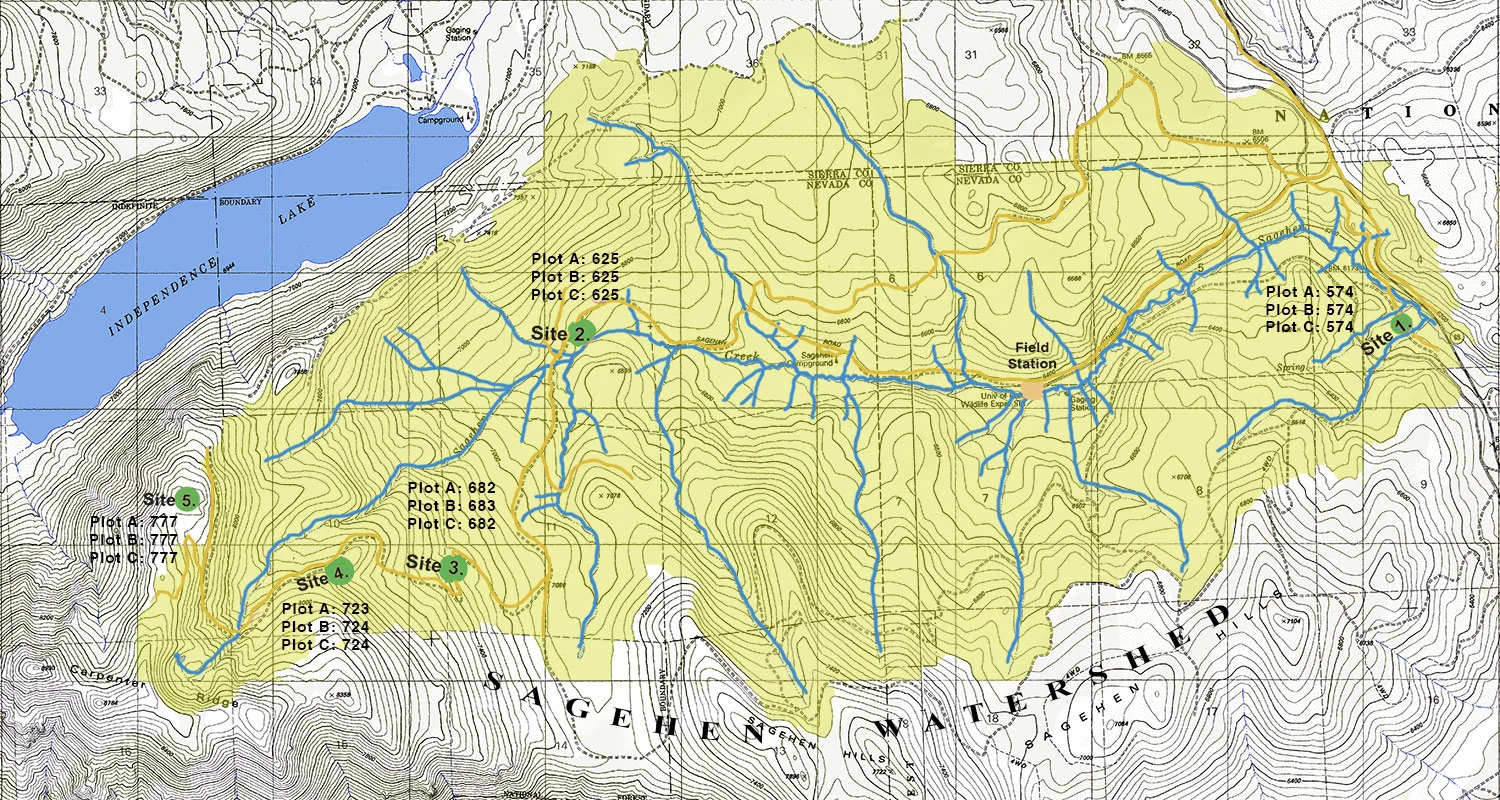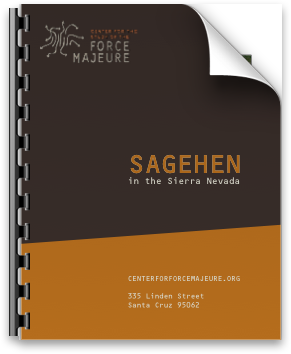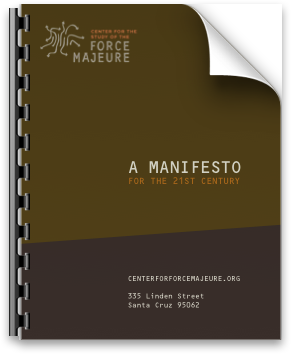PENINSULA EUROPE IV
By 2060, scientists expect a 20% decrease in river flows throughout Southern Europe due to climate changes. Combined with increased food demand, which is expected to double by 2050, Europe’s ability to produce its own food could face significant challenges & the probability of civil strife is high.
Imagine the research is right
drought moves across Europe
the temperature continues to rise
glacial melt continues accelerating
river flow becomes intermittent
flooding increases from sudden rains
the half-million sq km
of mostly monocultural high ground forest
succumbs in the main to drought and disease
How will the twenty republics
six kingdoms and one duchy
that are the European Union
surrender enough autonomy
surrender closely held powers
to create collectively
the new form of governance
that is able to meet
a force majeure of this magnitude?
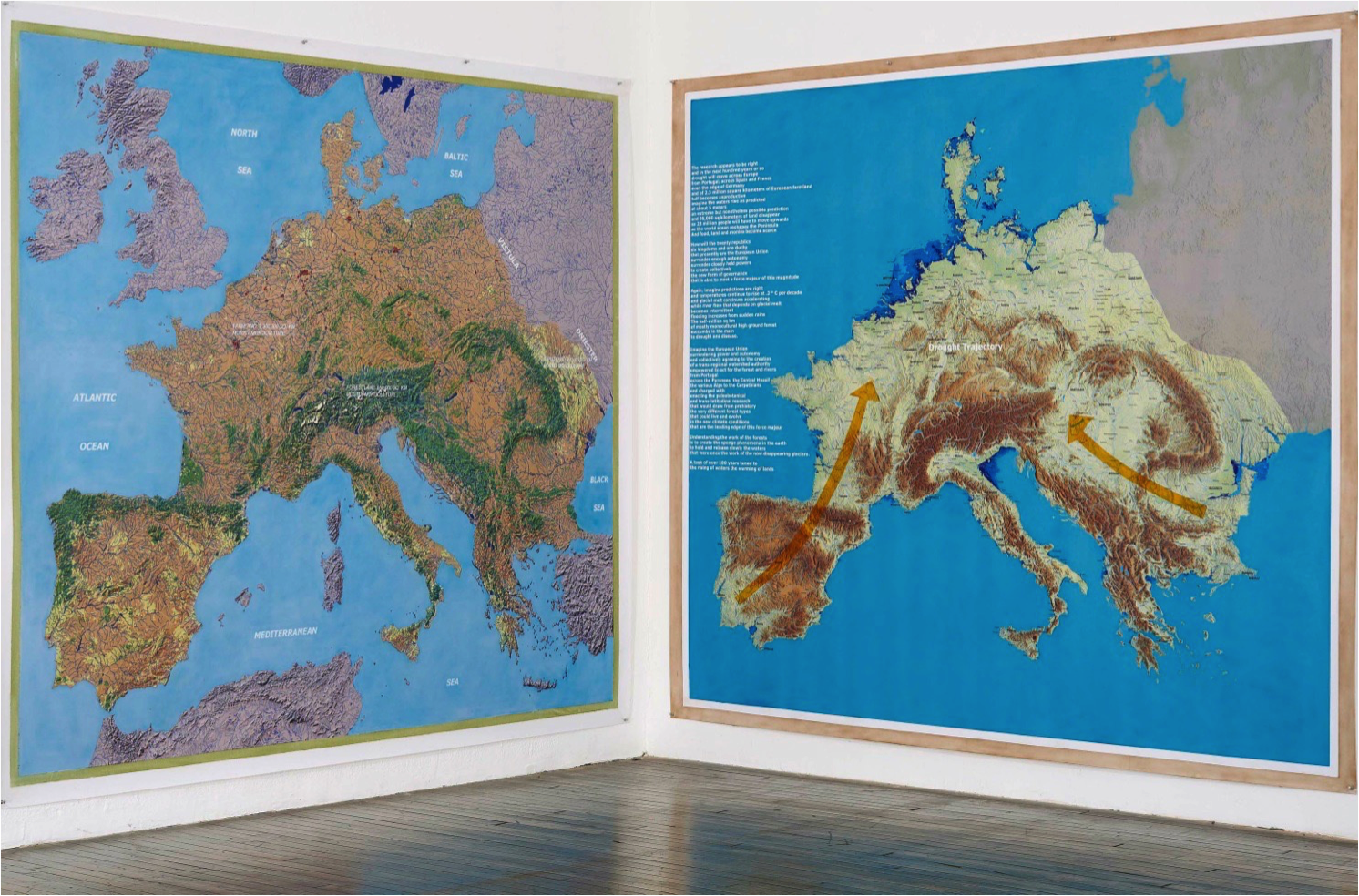
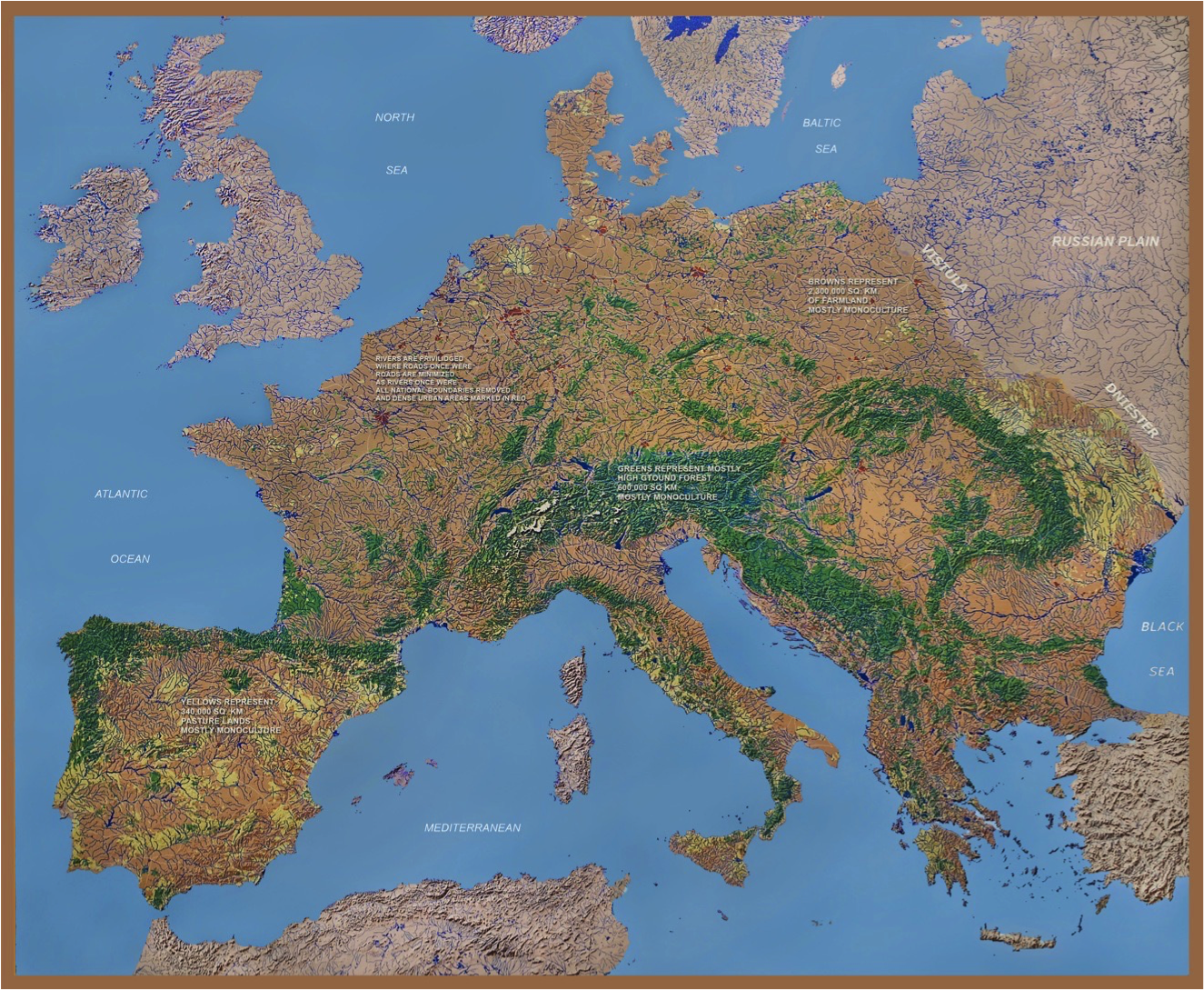

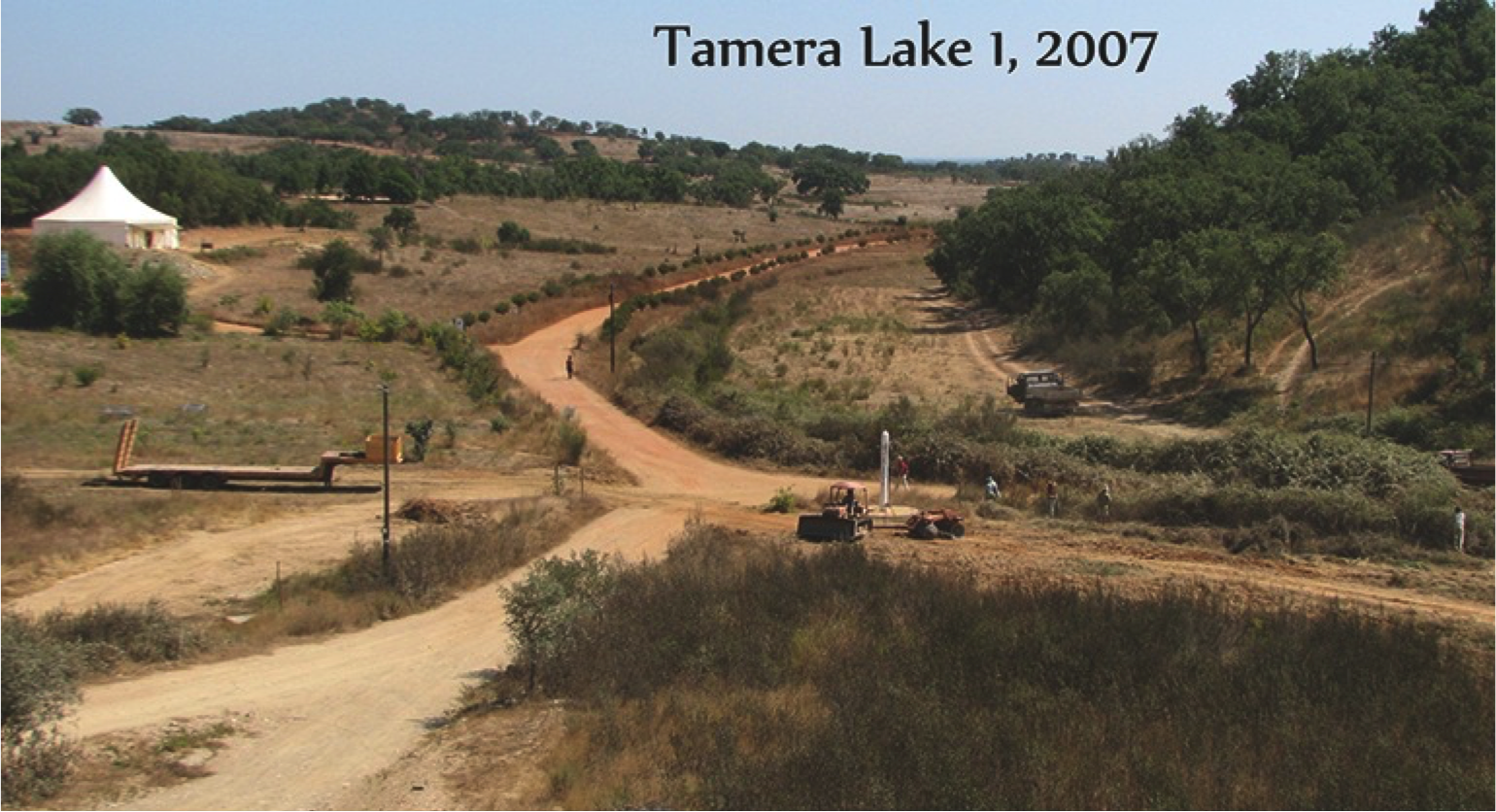

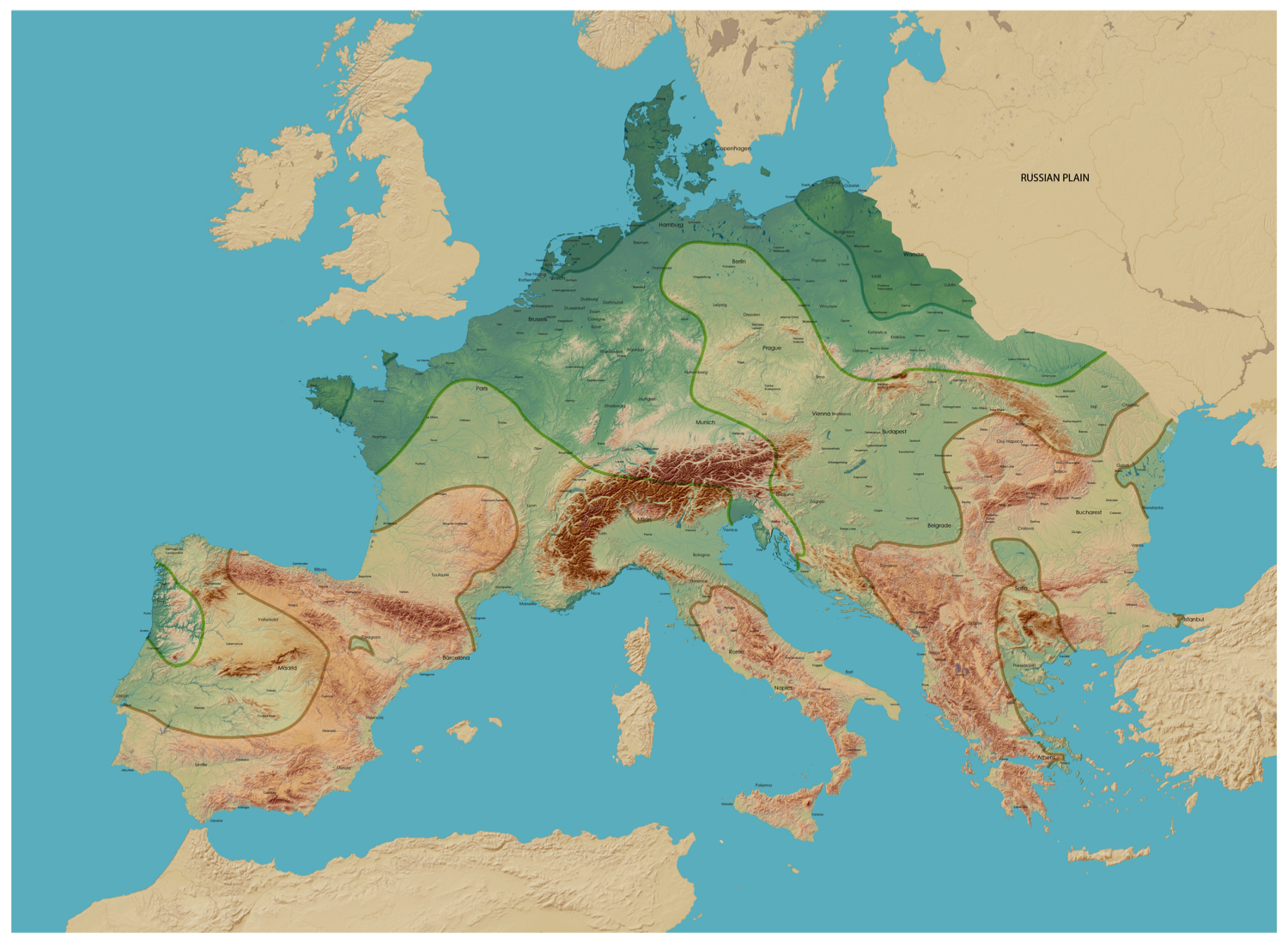
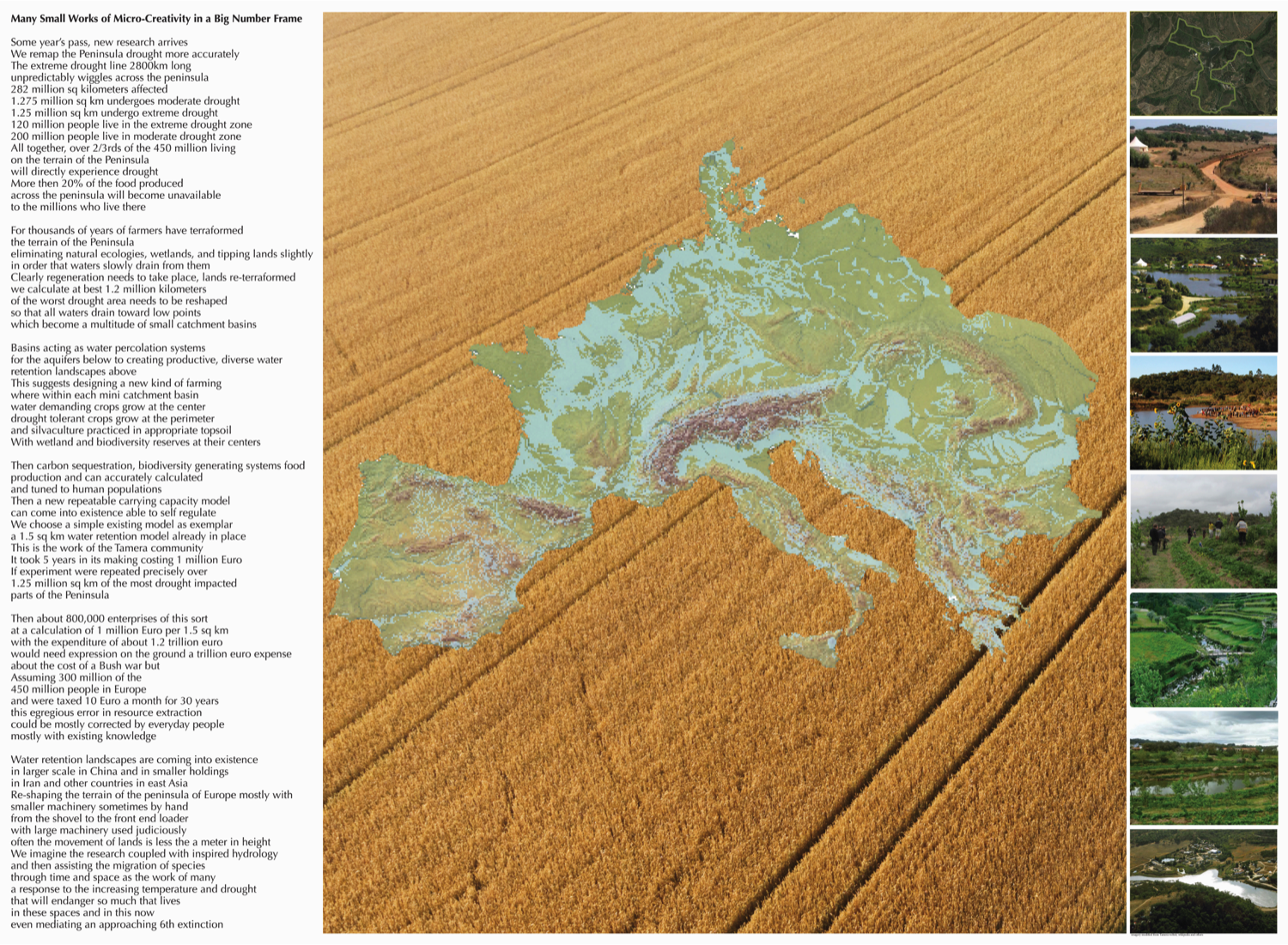
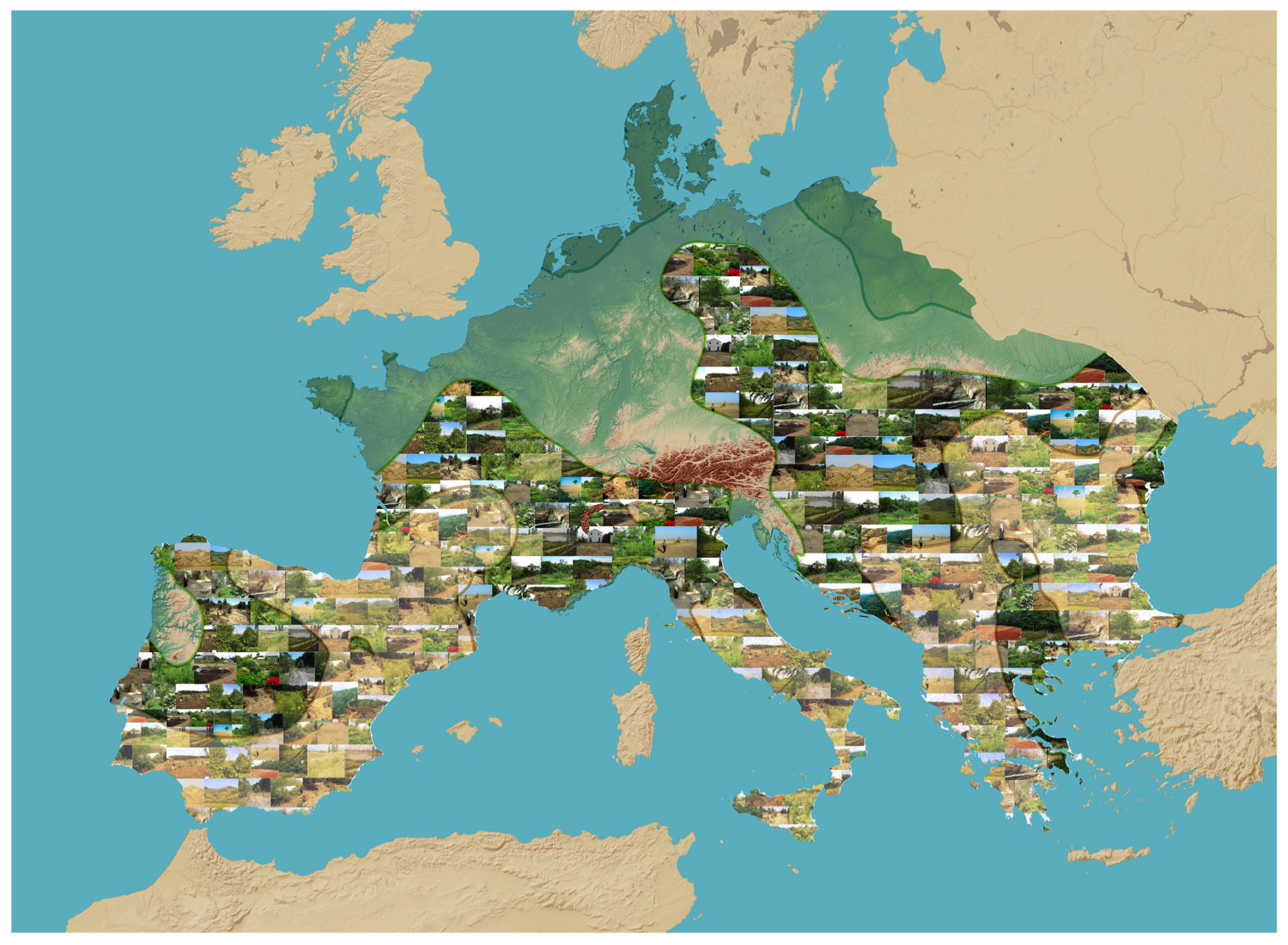
This prediction of drought has the following associated consequences:
One third of 2.3 million sq km of farming becomes minimally productive.
1/3 of 340 thousand sq km of meadowlands become minimally productive.
Most of the 560,000 sq km of high ground forest succumbs to insects, disease, drought and fire.
The outcome to civil society if business as usual practice continues is unfortunate in the extreme. We predict food rationing at best. At the worst, perturbation and collapse of society as we know it.
The decision is taken to reject the Alpine treeline definition of the high ground, instead locating where rivers begin to define the high ground, discovering that rivers begin mostly at 1200 feet and above. Lifting the shape off of the map, we discover an area of 1.46 million sq. km at the 1200 feet level that if rehabilitated according to the concept of the upward movement of species, will dramatically reduce the impact of the predicted tempera ture rise, flood and drought.
We suggested a water tax to the E.U. representative who posed the money question of “ how much will it cost and where will money be found?” We suggested that rehabilitating 1.4 million sq. km. would cost well over a trillion dollars to be spent over 50 years. It appears that if water is generated and saved then valued at one euro per cubic meter, then hundreds of millions of cubic meters created would be an economic generator. This would more than cover these costs over a 50-year period. Thereafter the cost would go down and the profit would go up, and a virtuous cycle would be put in place by the processes of rehabilitation.
THE BAYS OF SAN FRANCISCO
become a 400,000-acre estuarial lagoon when the oceans rise about 3 meters.
As ocean waters rise and storm surges happen, the probability is that, prior to stabilization, storm surges will force the waters from the Bays out into the desert toward Stockton to the West, and Sacramento to the East. The probability is that the waters from the storm surges will remain in place, forming saline lakes, sometimes as deep as 4 or 5 meters. For the purposes of this investigation and work of Art, we pose a limit to the ocean rise of about 3 meters, which generates the vast estuarial lagoon this proposal suggests.
We choose the 3-meter mark somewhat arbitrarily. The lowest prediction of water rise over the next 100 years is approximately 1m, the largest, approximately 5m. We choose the 3-meter mark as the most probable. We also note that climatological research suggests a 6-7 degree F. temperature rise in that region.
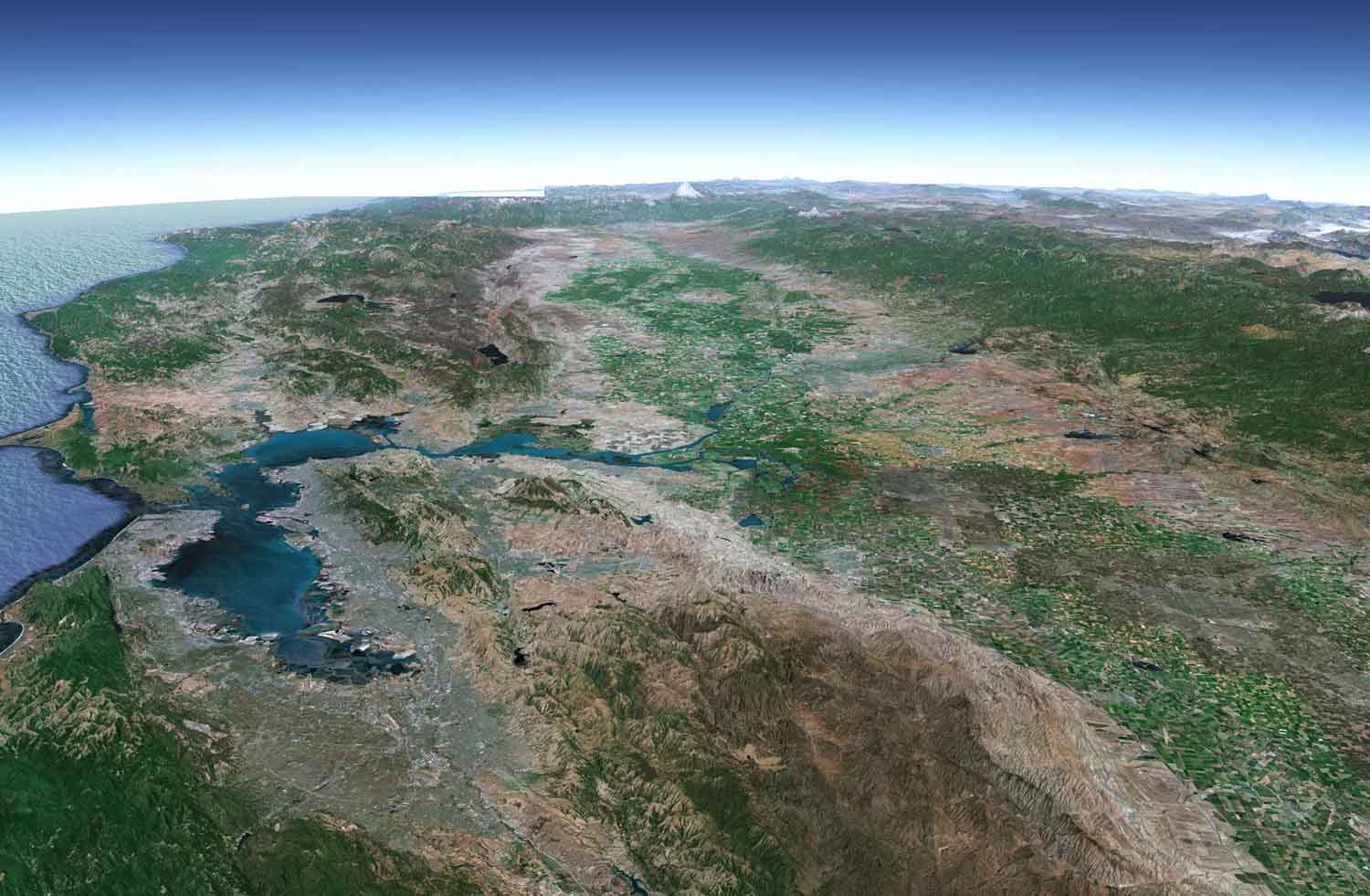
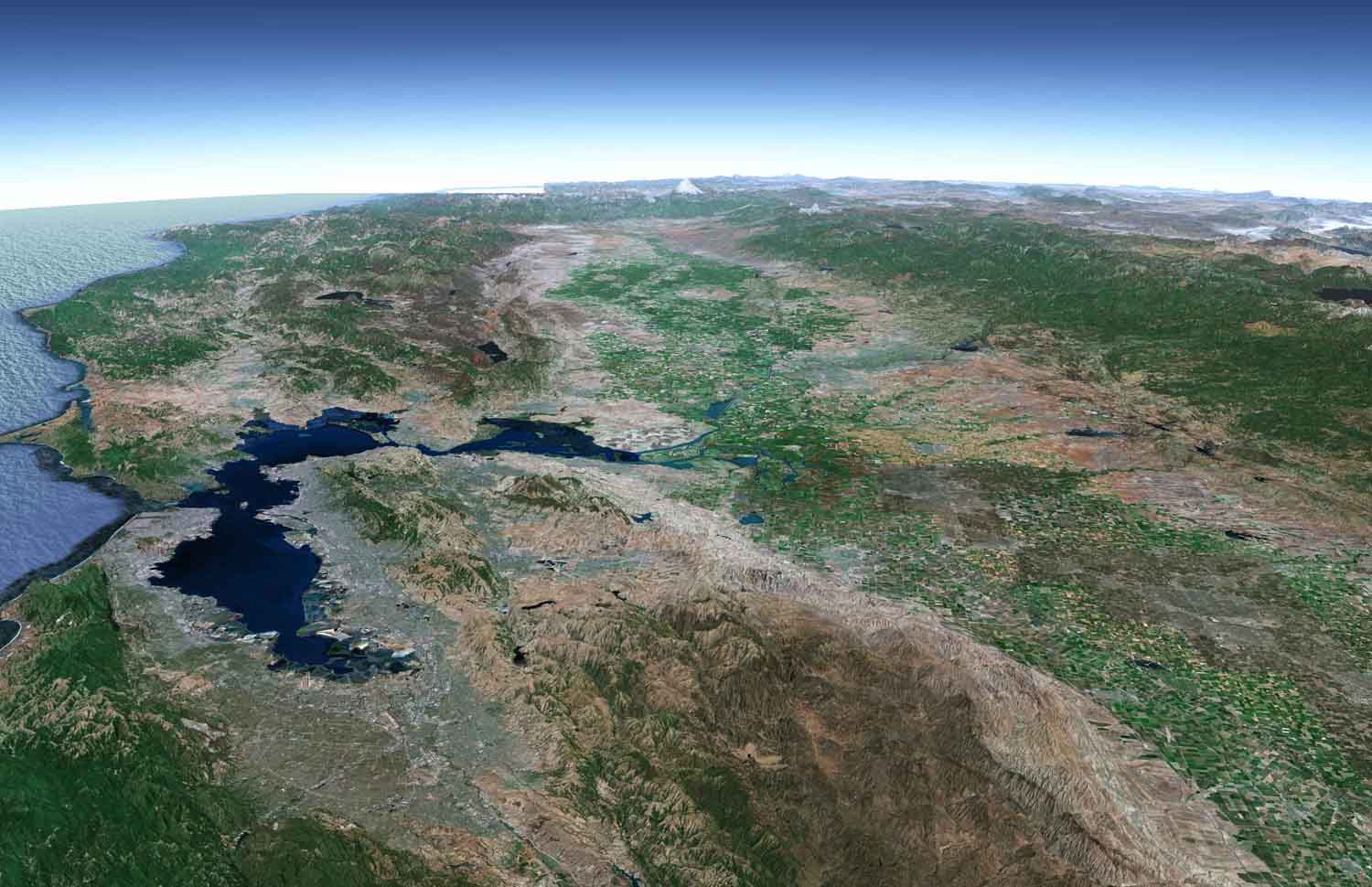
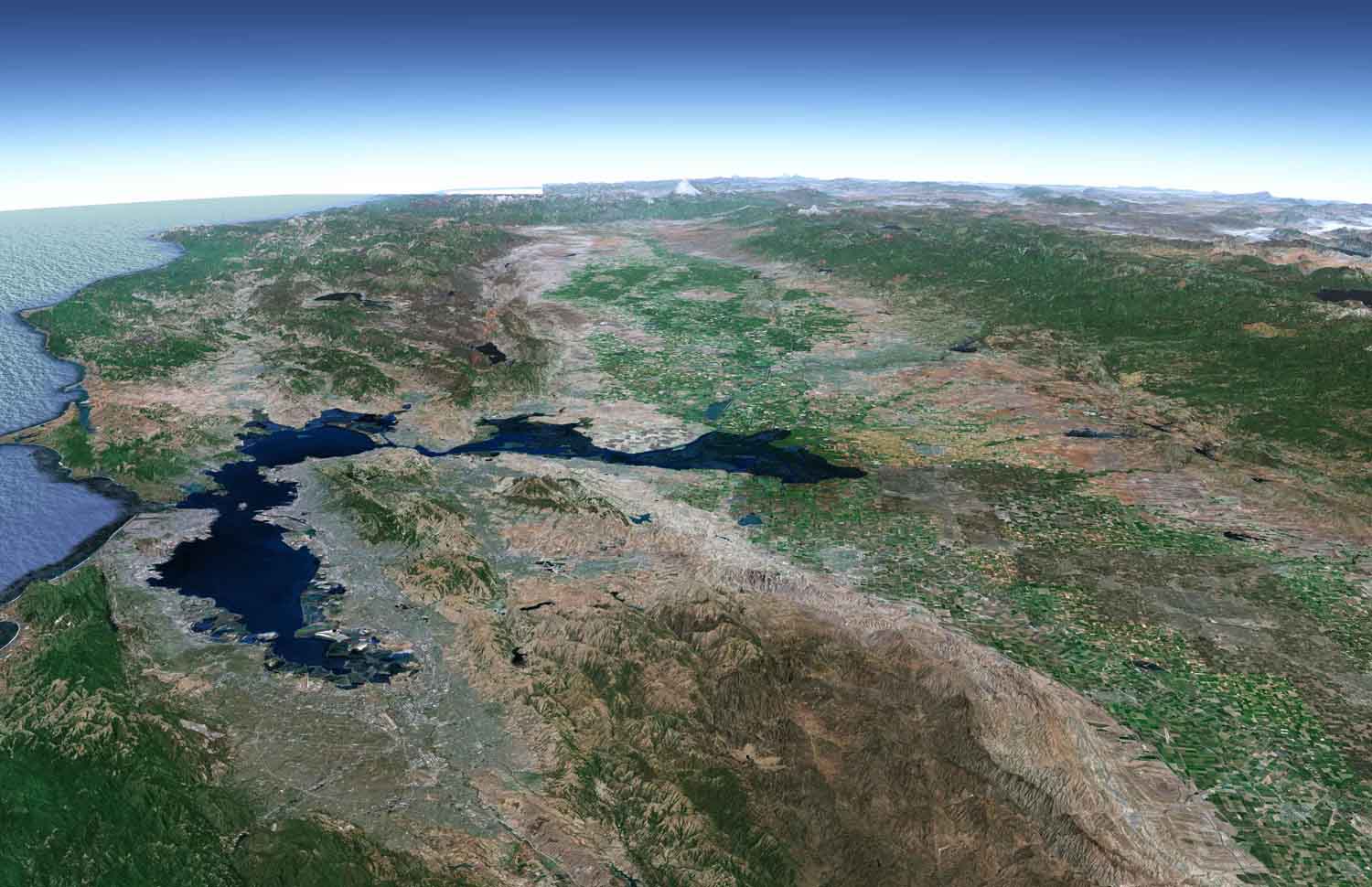
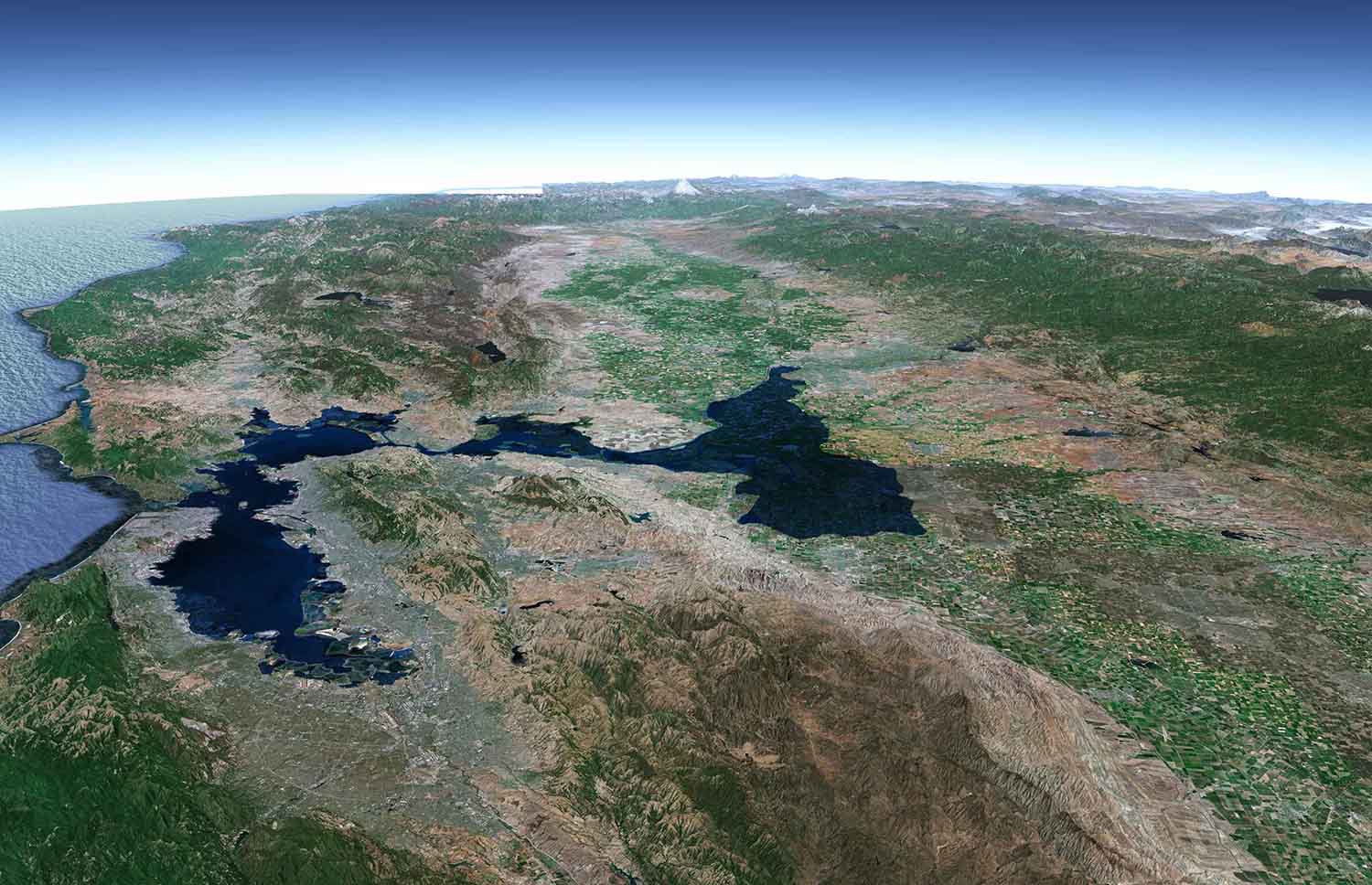

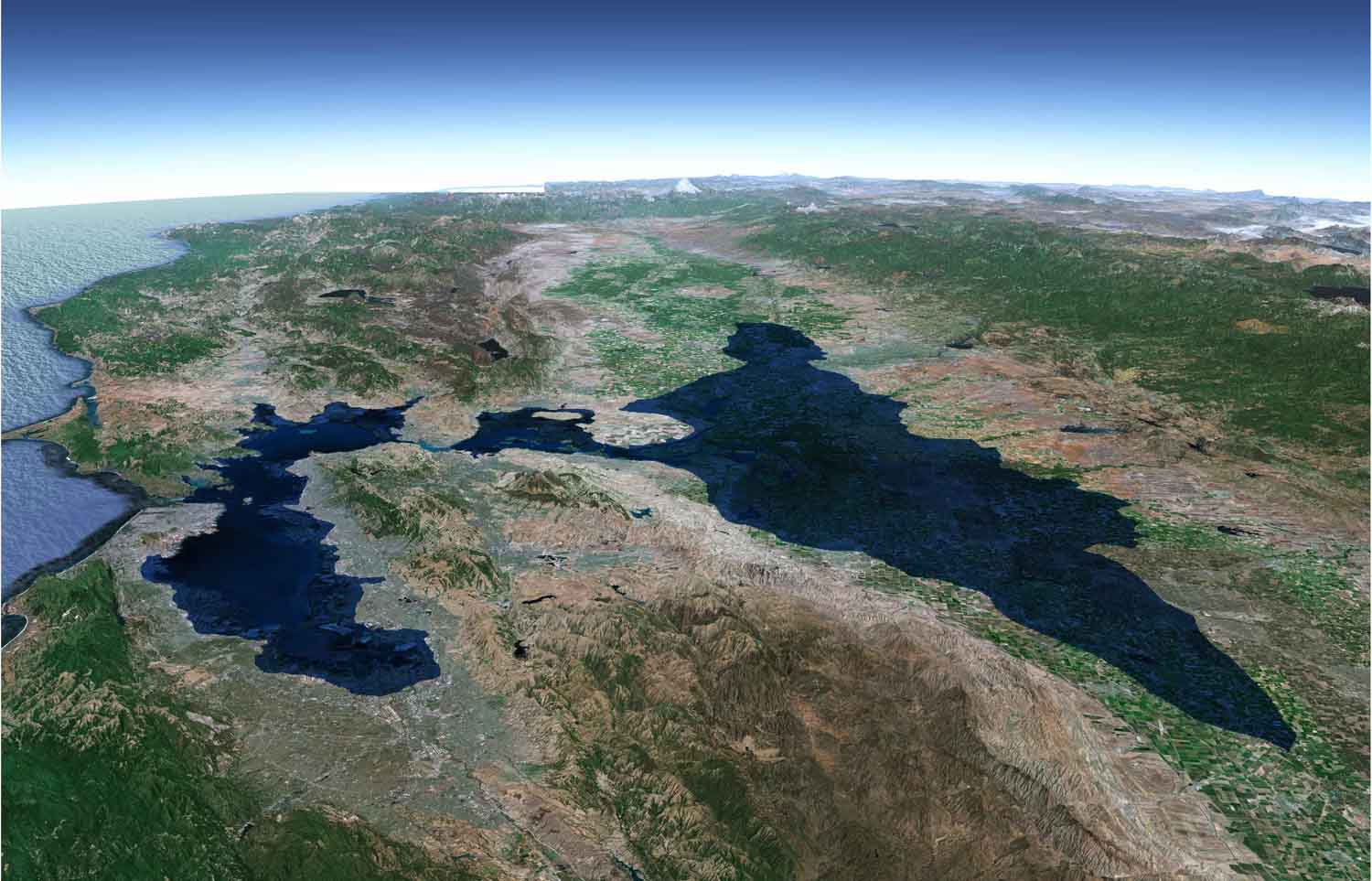
In an estuarial lagoon, it is the mixing of fresh and salt waters that creates the particular and productive ecosystem that evolves and has tolerance to waters of varying salinity. We therefore propose a planning group that will first analyze the terrain and then begin to come to an understanding of the species that would move there from warmer parts of the Pacific if they could. Also such a group would be tasked with the design and framing of the planning and research necessary to do this work. Particularly important is to come to an understanding of whether and how to assist the migration of species that would permit a future healthy, vibrant and productive estuarial lagoon to come into being. This work would require serious paleo-ecological research to find out which species lived there when the salt waters were present in the central valley and when the temperatures were, on average and as predicted, 7 degrees F. higher. This form of research is of great value in shedding light on what a new ecosystem might both look and behave like.
Moreover, it is our intention to locate, on the Pacific shores, possibly in Mexico or below, what we have come to think of as a “Mother Lagoon.” That is, an estuarial lagoon that has a presence in a desert, fed by mountain streams at temperatures as high or higher than the Central Valley. We believe studying the ecology that exists in such a lagoon will, like studying the Eemian, shed light on how we might assist Nature in bringing forth a viable estuarine ecosystem in the Central Valley.
For instance, from an economic perspective, a 400,000-acre estuarial lagoon will produce approximately 2,000 pounds per acre when it becomes a low-intensity aquasystem. In this case we are looking at a production of 800 million pounds, wet weight, yearly. The requirement here is that those that harvest the system maintain the system, thus the top predetor and the top conservator are one.
The likelihood is that carbon in the atmosphere will reach much higher levels, perhaps over 600 parts per million, and the global temperature will rise above the 2 degrees C. that signal ecological danger. Therefore, this work argues that conceiving and planning for adaptation at scale is a virtual efficiency that needs to be enacted in the now. The virtual efficiency we suggest would be in initiating the coping processes, well prior to extreme future need.
THE DEEP WEALTH OF THIS NATION, SCOTLAND
We were contacted as sometimes happens, on behalf of an arts center called The Barn, Anne Douglas and Mark Hope were wondering if we would come to Scotland and do a work, maybe addressing flood control.
We said yes, then maybe, then seeing that the Dee and the Don watersheds join at their outfalls on either side of the city of Aberdeen, and that the local farming had interfered with the floodplains of these rivers, we wrote back saying let us do a work for the Dee and the Don, and let the Dee and the Don tell us what to do. So as we often do, we requested a cessna flight over the rivers to really see these watersheds and photograph.
So the twin watersheds then became as a model for a larger vision we have developed called, The Deep Wealth of This Nation, Scotland. The guiding narrative for this initial large scale is a poem. As is typical for our work, it functions as an initial guiding metaphor for thinking and inspired the generation of this imagery.
The Barn Arts Center exhibition announcement
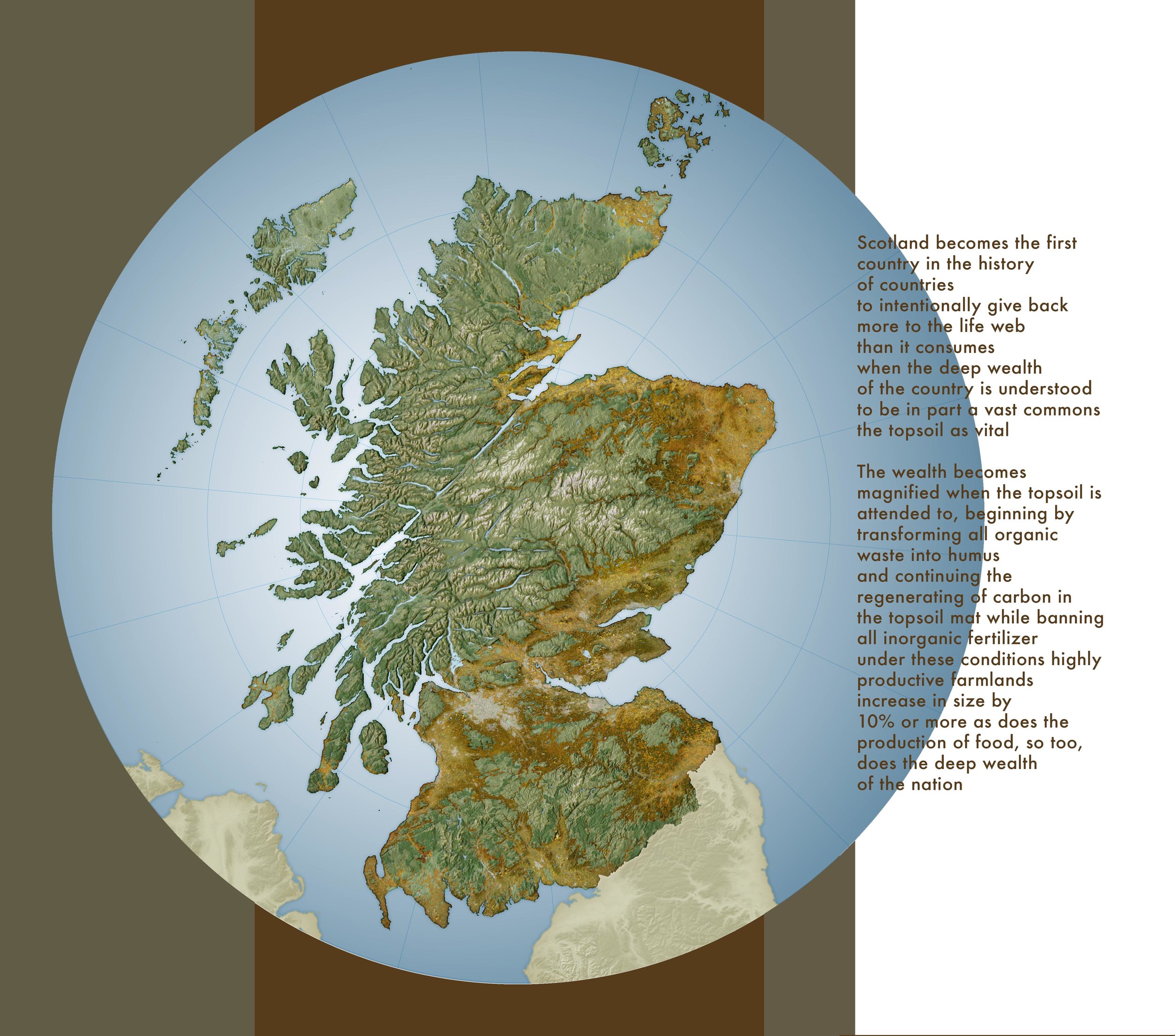


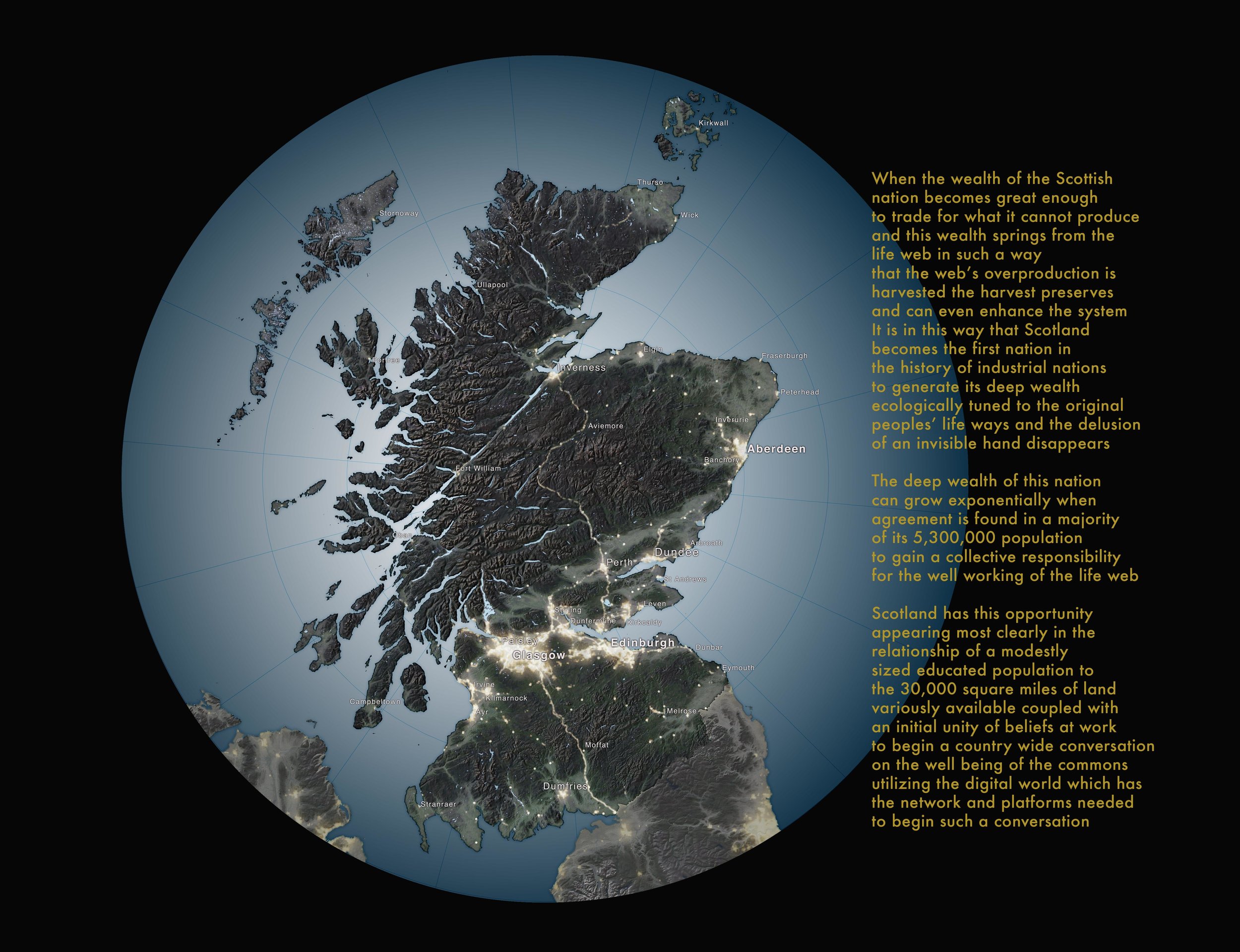
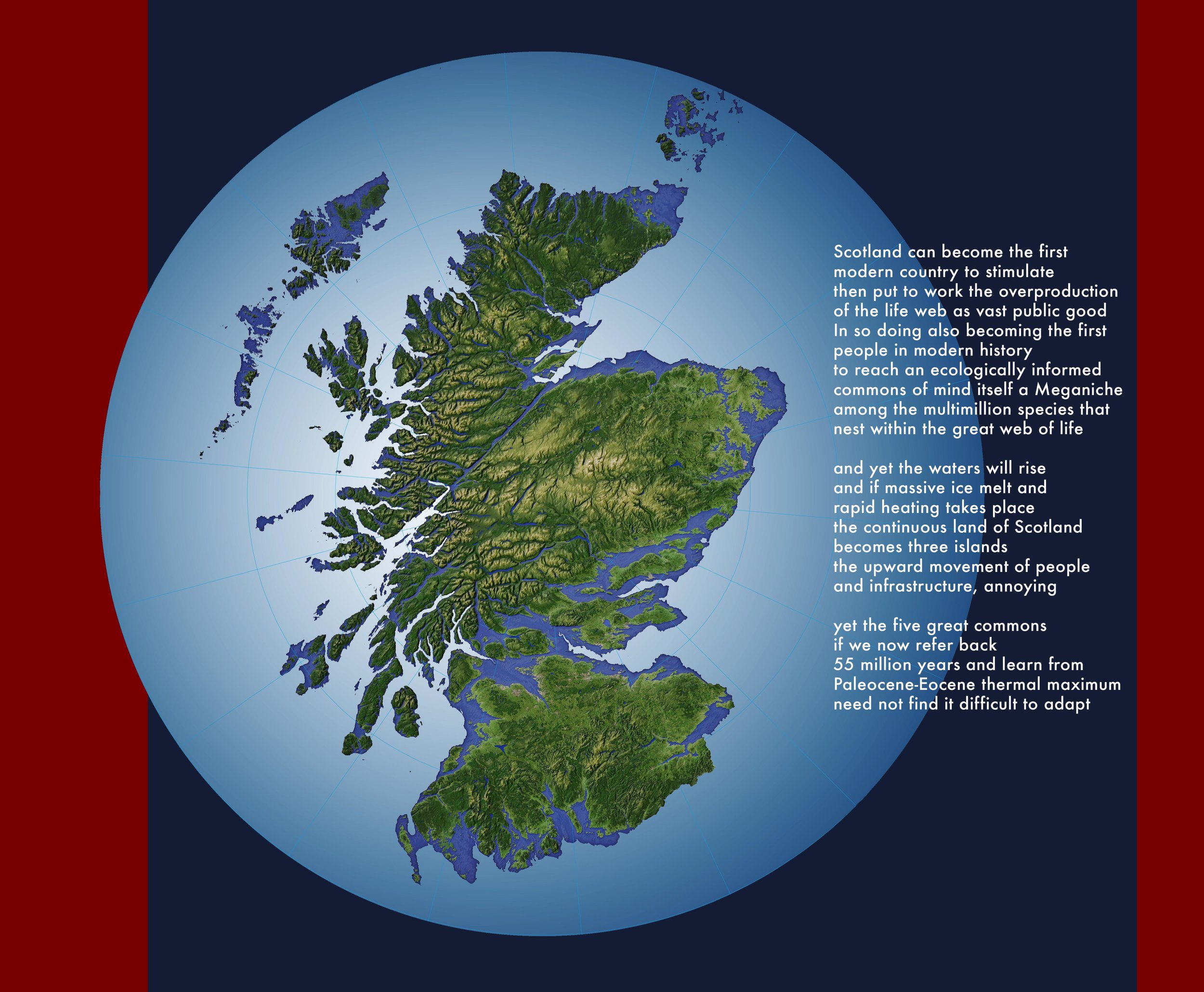
TIBET IS THE HIGH GROUND
The research of Chinese glaciologists and glaciologist from India appears to be right: 80% of glaciers in Tibet and surrounding areas can disappear in the next 35 years.
A Force Majeure has come into being in the form of global warming that will work to the disadvantage of about 1.2 billion people who live in the 7 drain Basins that comprise 2,404,820 square miles of continental Asia. It is not clear that countries can overcome their differences in order to create a counter force at virtually continental scale. Profoundly affecting the Salween, MeKong, Huang-Ho, Brahmaputra, Yangtze, Ganges and Indus River systems that traverse inner Mongolia, China, Tibet, Autonomous-Zone, India, Burma, Laos, Cambodia, South Vietnam, Bangladesh, Kashmir and Pakistan. Thus, we make an unlikely proposal.
Clearly industry can play a mediating role in this highly stressed probable future by generating first the funding that will enable bioregional and paleobotanical research to locate forest and savannah ecosystems that existed in the millennia past, when temperatures were similar to those which are in the process of happening in our now, and thereafter to locate the local similar or equivalent ecosystems that exist in our now. And then to begin designing, as well as in part creating, by assisting the migration of species that might be able to replace or restate those now coming under extreme stress, to make new species palettes, which in conjunction with new forest and grassland might, in good part, be able to replace the water holding properties of glaciers to normalize river systems. This would also be an adaptation at sufficient scale able to sequester 6 gigatons of carbon every decade.
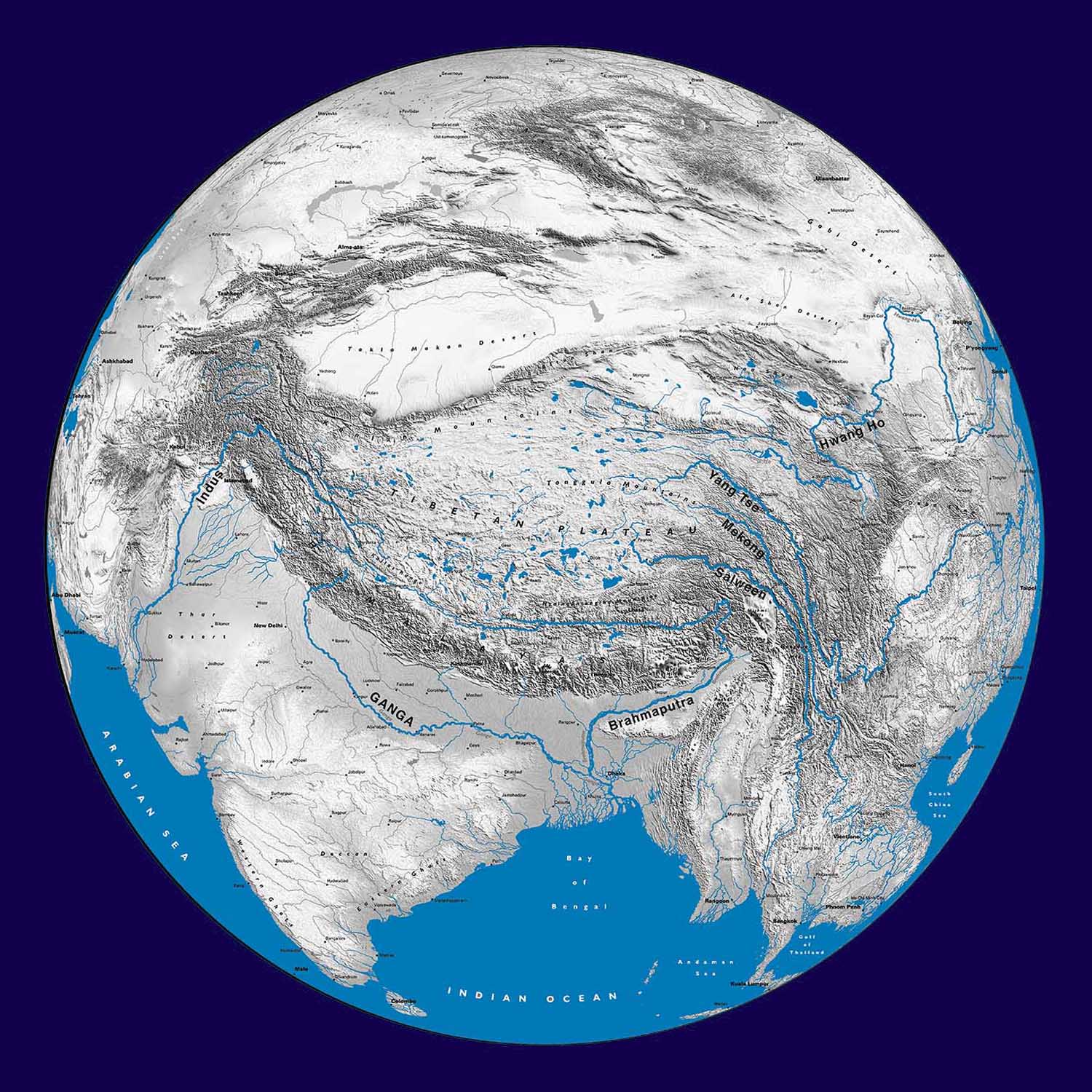
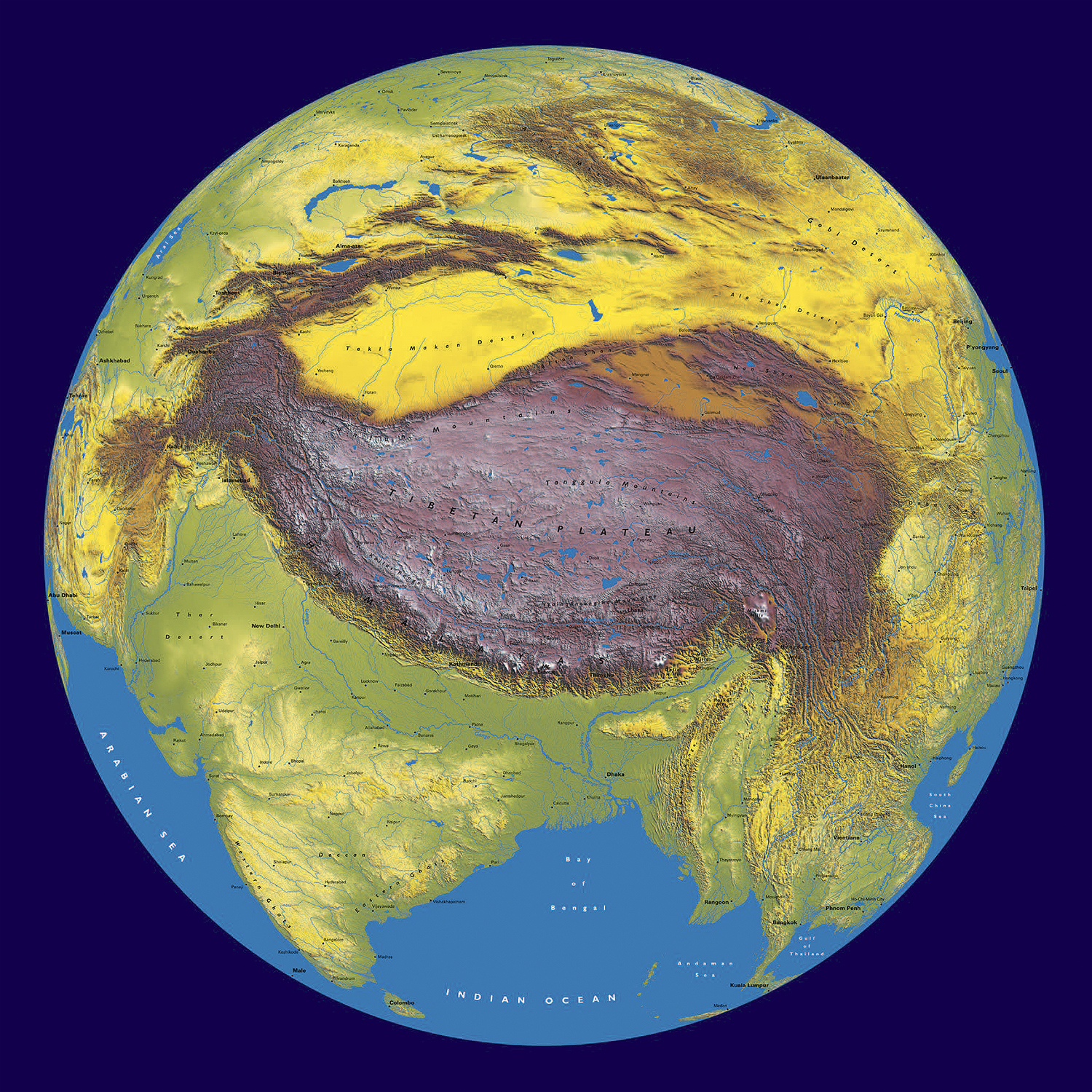
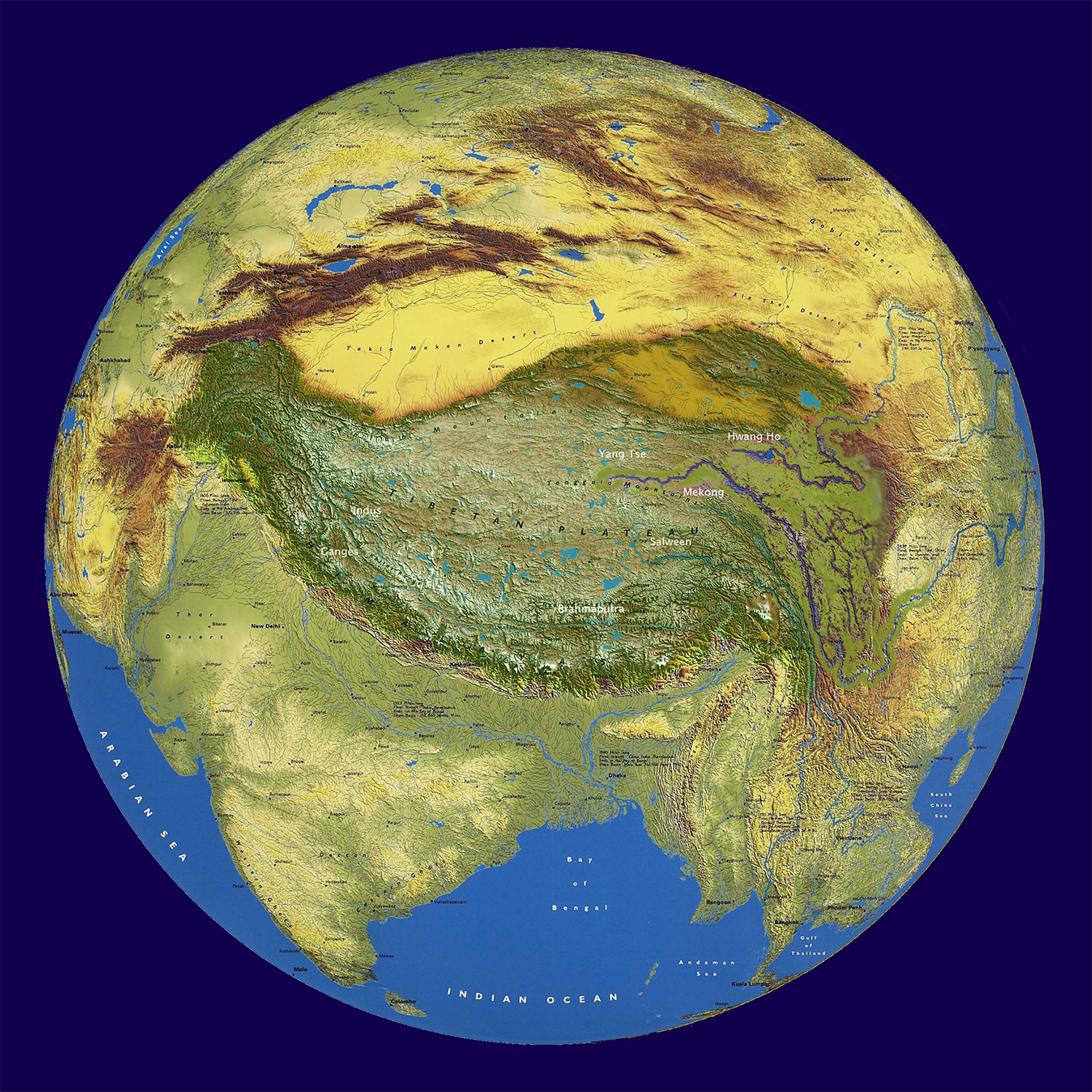
With ice melt and snow melt and temperature rise of 10 degrees F, the 2.4 million square km. of the Tibetan Plateau will suffer stress to such a degree that the seven rivers that flow from it, nurturing much of Asia, will be subject to flood and drought. A Force Majeure is at work.
The Center poses the following questions and seeks an answer. Is there a whole systems ecological response, a systemic adaptation at the 2 million-km. scale? We think yes. Nature has done this before but not, at least according to recent research, in the past 65 million years. The core of the question proposed by the Center is, “Can the assisted migration of these species and the assisted development of succession ecosystems be done in a hundred-year time-frame, thus mediating ecological and human stress by developing what amounts to be a vast water-holding, carbon-sequestering, food-producing ecosystem at this scale?” Somebody said, “How much will an adaptation at this scale cost?” After a brief study we came up with the tentative amount of 1.3 trillion dollars for a million sq. km. over a 50-year period, or 2.6 trillion dollars for the 2 million sq. km. that is the Tibetan Plain. That is to say, not much more than the recent wars, maybe even less, when all costs are calculated. In fact, unlike the destructive remnants of war, a constructive cycle will come into being where over time this emmerging system will produce more value than it consumes.
The research, although by no means complete yet, suggests a trillion dollar, ecologically based commercial enterprise is needed to respond to the Force Majeure at scale.
Sagehen: A Proving Ground
Funded by the Annenberg Foundation
At present, the Harrison Studio, the Nevada Museum of Art, and the 9,000-acre University of California Sagehen Creek Research Station are engaged in and committed to a 50-year long research project (“Sagehen: A Proving Ground”). It is a work of art, a work of science, a work of bio-regional planning, and a work that calls for policy change.
The Project is designed to field test, in a formal research setting, core concepts which the Harrison Studio has been working with. This is, in brief, testing the value to ecosystems of assisting the migration of species. The project will be designed to answer, on the ground, the question posed earlier: Are there ecologically available responses that will, in part, replace the value provided by disappearing glaciers to river systems and the human cultures they support?
The Experimental Design
The concepts expressed so far were presented to the Metabolic Studio. We requested $220,000 dollars to enact the Sagehen experiment which is described below. These monies were granted.
The first serious expenditures from the grant were hiring on the scientific director Brett Hall, who was simultaneously the director of the UC Santa Cruz Arboretum and hiring Elizabeth Thompson, a person of broad accomplishment, to manage the center for the “Study of the Force Majeure” and to oversee its development.
After approval by various authorities that would permit us to proceed, we began a search for scientists, particularly botanists, who knew the area and could select both seeds and cuttings from a large section of the plant community of the Sagehen Watershed to test the viability to move upward.
The sites were chosen for their commonality of earth type. Each site is approximately 150 meters above the prior one. Their placement spans a little over 750 meters of altitude from close to the lower portion to Carpenters Ridge, which is at the top of the Sagehen Drain Basin.
The sites were chosen by ourselves and the senior scientist on the project, Brett Hall. A committee of three other botanists who know the area were chosen to add breadth and diversity to the process of selecting species that would be most appropriate in this field test.
The experiment itself will take the form of three 20x40 fenced areas that will act as controls for each other on each of the five sites. Each fenced area is 800 square feet. Each fenced area will be somewhat over-planted with the same species and will have approximately 800 species at the beginning of the experiment. That is one plant per square foot.
There will be, therefore, 15 fenced areas in total, 3 per site, on the 5 sites selected. The first species grouping will be selected for having capacities described earlier. With particular emphasis for their ability to adapt to drought, hold water in the grounds to enhance the sponge effect, be fire tolerant, and function well collectively from a biodiverse perspective.
Each fenced area will have an 8’ fence that is removable in the winter but otherwise protects new growth from the encroachment of the deer population.
Each fenced area will have a mounted camera, 15 cameras in total, that will take pictures on a daily basis and systematically archived. These images will then be used for comparative review from a scientific perspective and as visual feedback of organization into a narrative that will carry the aesthetic power and meaning of the experiment and the experience to a non-scientific audience, both in the Nevada Museum of Art and in the field station itself.
We cannot predict, at the moment, which species will survive and do well at all altitudes. The first year or two of experiments is to determine this. The second and third year is to re-plant those that had survived at all altitudes. The process will be recorded not only by camera, but also by field observation.





